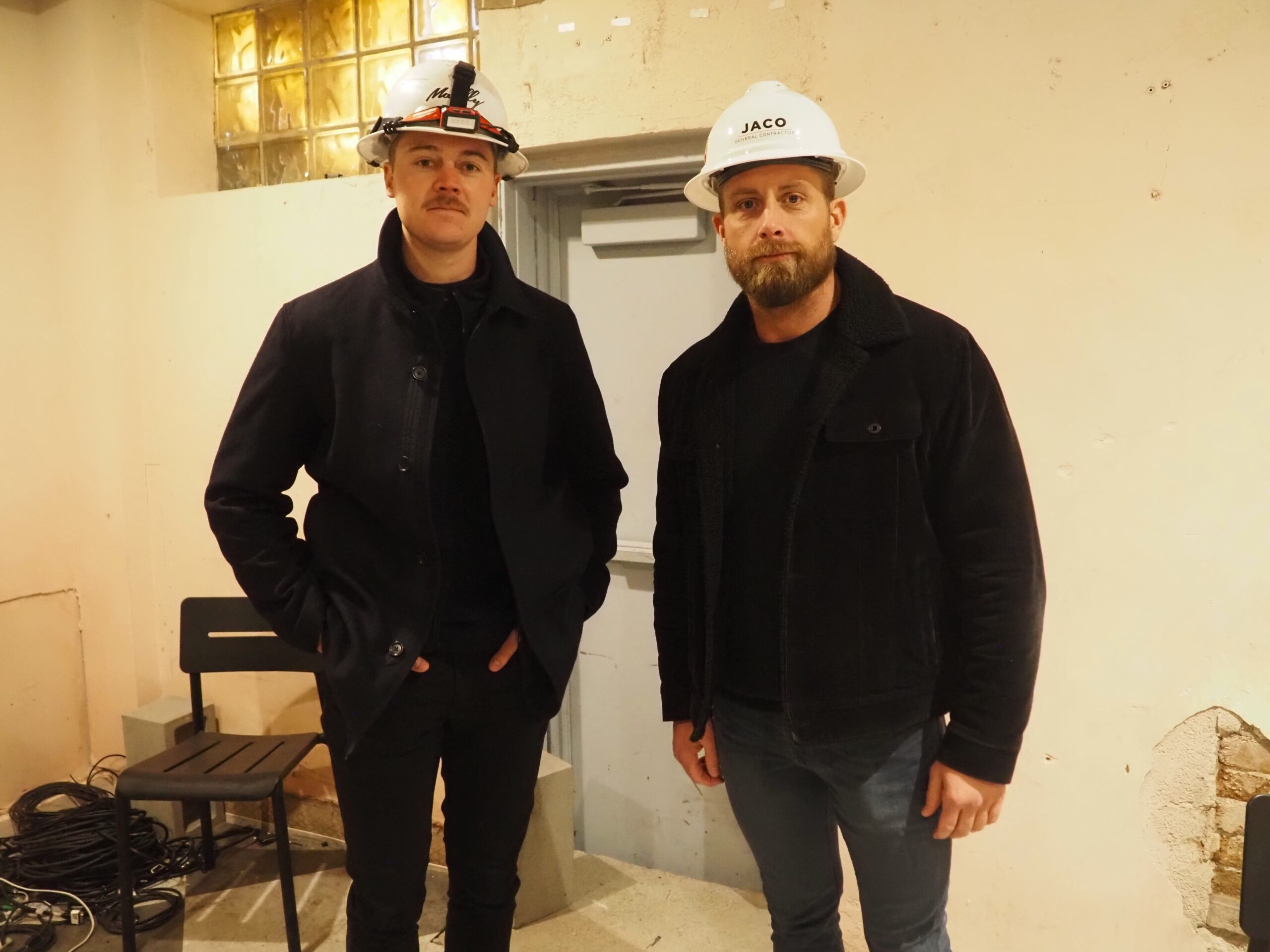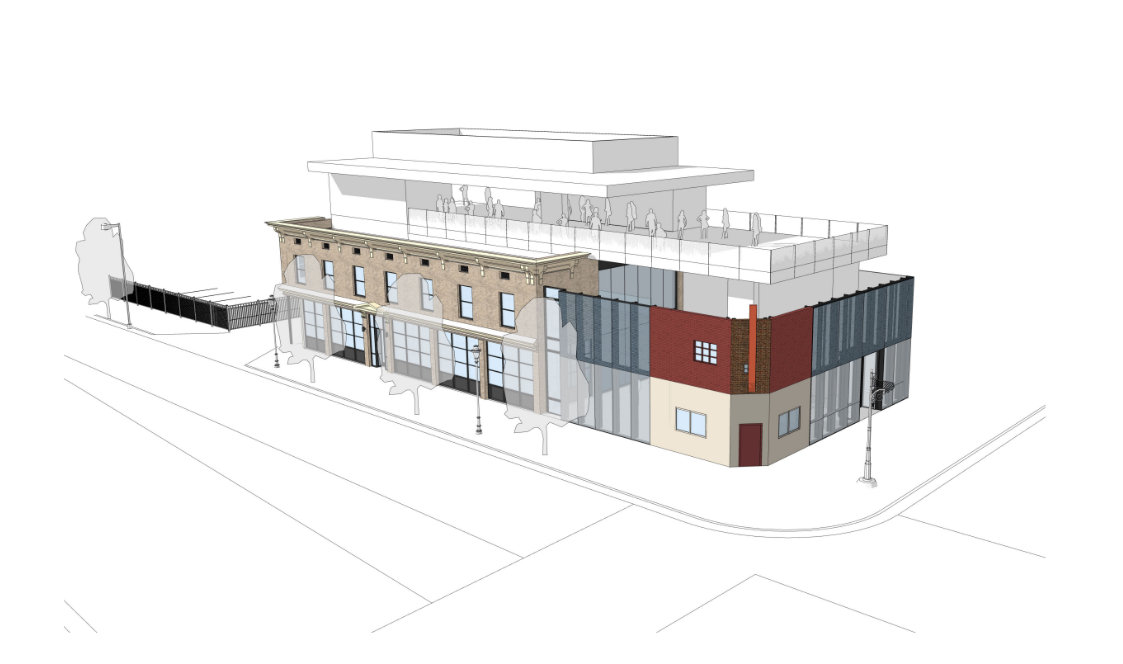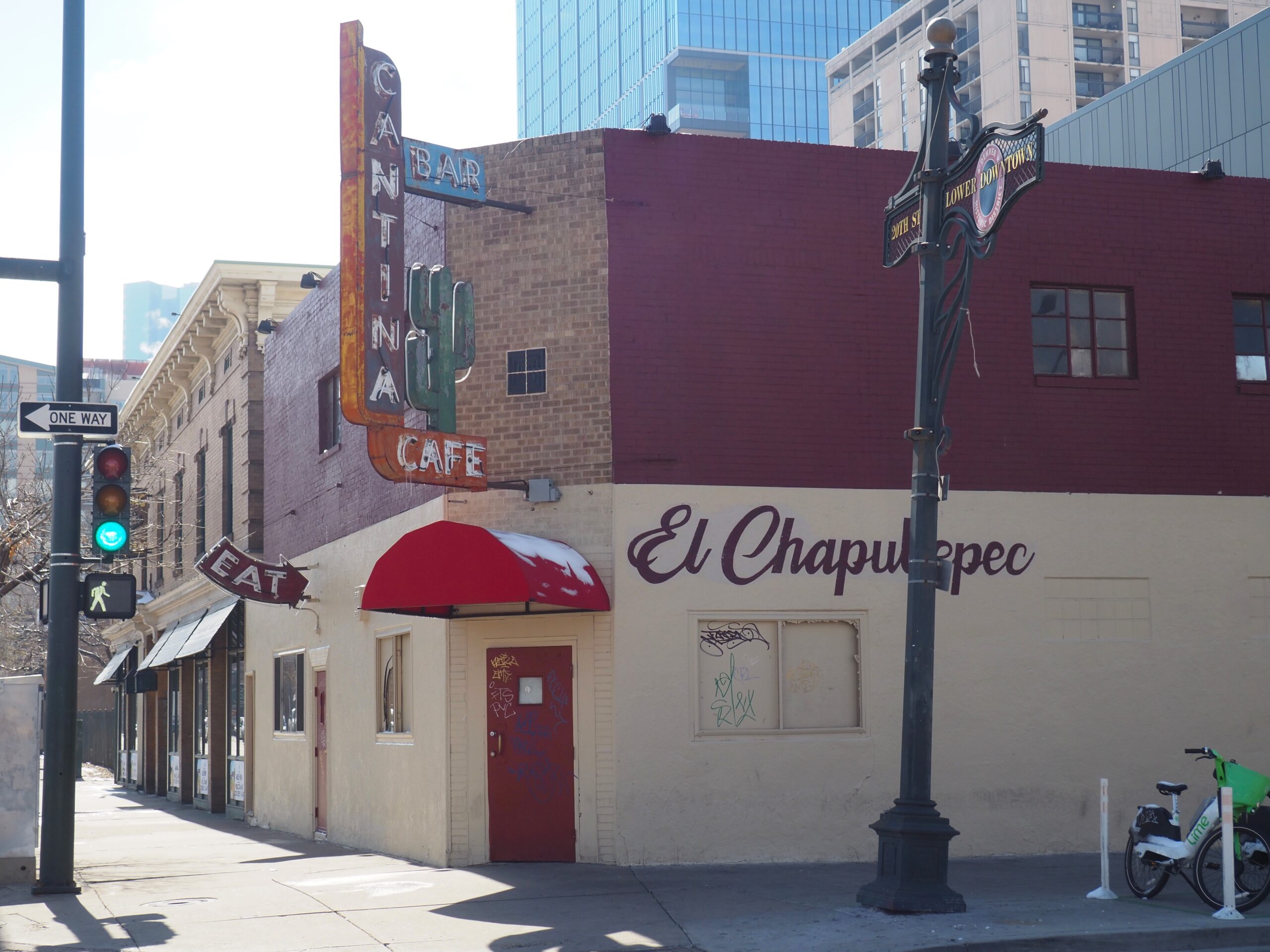
Kenneth Monfort, left, and Matt Runyon of Monfort Cos. stand in the former El Chapultepec building on Tuesday, March 26, 2024. (BusinessDen file)
The owner of the former El Chapultepec building has reached a deal with the nonprofit Historic Denver to preserve a portion of the structure near Coors Field.
The deal calls for Monfort Cos. to essentially preserve the building’s corner, keeping much of the brick facade surrounding the main entrance at 20th and Market streets.
Glass walls, meanwhile, will extend from there, maintaining the silhouette of the existing building. The glass will be etched so as to resemble the existing brick.
A portion of the original materials making up the north and west-facing walls, as well as neon signs on the building, will also be maintained.
“Our intent here was preserving, while telling the story, while also delivering an outcome that is operational from a business perspective at the end of the day,” said Kenneth Monfort, executive vice president of Monfort Cos.

An image showing the new proposal for the El Chapultepec and Giggling Grizzly buildings. (Courtesy Monfort Cos.)
The deal was announced Tuesday, after about three months of talks between Monfort and Historic Denver CEO John Deffenbaugh, as well as other parties.
“It’s really important to retain enough of the existing building to ensure that people are continually reminded of what happened here, the memories that were made here, the music that was made here, and that those memories remain fresh and lasting into the future,” Deffenbaugh said.
El Chapultepec opened the day after Prohibition ended in 1933, and over the decades became a Denver institution, hosting local and touring jazz musicians. But owners Anna Diaz and Angela Guerrero closed for good in late 2020. Monfort paid $5.4 million two years later for the Pec and adjacent Giggling Grizzly building.
As of mid-March, Monfort, whose father and uncle are the majority owners of the Colorado Rockies, planned to demolish the 1962 Market St. building and turn its footprint into a covered patio for a new concept incorporating the Giggling Grizzly building.

El Chapultepec operated for 87 years at the corner of 20th and Market before closing in 2020. (BusinessDen file)
Monfort had decided the Pec building was in too poor of a condition to preserve. But on the same day he submitted plans to a city design commission, Deffenbaugh’s organization made a submission of its own, asking Denver to name 1962 Market St. a city landmark.
That status, if approved, would have effectively prevented demolition of the structure.
As part of the deal reached this week, Historic Denver has withdrawn its landmark designation application. And Monfort has submitted a new set of plans to the Lower Downtown Design Review Commission.
The plans are expected to be reviewed next month. Assuming they are approved, Monfort said he expects to spend eight months on entitlements, then 10 months on construction, which would put completion sometime around early 2026.

John Deffenbaugh
Monfort said the changes will add about $1 million to the cost of construction compared to his earlier plans. And he said the three-month delay also added another $1 million in costs.
Deffenbaugh, who joined Monfort Tuesday for a series of video calls with local media, said he saw discussion of the additional costs as a “false narrative.”
“We appreciate and acknowledge the funding that Kenny and the team are putting into this and we’re confident it’s going to create a great outcome,” he said. “But when you are working with a historically significant building, that does require a sensitivity and a level of investment that is required to get to a high-quality result.”
This is Monfort’s third project in the 1900 block of Market. He’s already opened Dierks Bentley’s Whiskey Row and Riot House, both of which involved at least partially refashioning existing structures.

Kenneth Monfort, left, and Matt Runyon of Monfort Cos. stand in the former El Chapultepec building on Tuesday, March 26, 2024. (BusinessDen file)
The owner of the former El Chapultepec building has reached a deal with the nonprofit Historic Denver to preserve a portion of the structure near Coors Field.
The deal calls for Monfort Cos. to essentially preserve the building’s corner, keeping much of the brick facade surrounding the main entrance at 20th and Market streets.
Glass walls, meanwhile, will extend from there, maintaining the silhouette of the existing building. The glass will be etched so as to resemble the existing brick.
A portion of the original materials making up the north and west-facing walls, as well as neon signs on the building, will also be maintained.
“Our intent here was preserving, while telling the story, while also delivering an outcome that is operational from a business perspective at the end of the day,” said Kenneth Monfort, executive vice president of Monfort Cos.

An image showing the new proposal for the El Chapultepec and Giggling Grizzly buildings. (Courtesy Monfort Cos.)
The deal was announced Tuesday, after about three months of talks between Monfort and Historic Denver CEO John Deffenbaugh, as well as other parties.
“It’s really important to retain enough of the existing building to ensure that people are continually reminded of what happened here, the memories that were made here, the music that was made here, and that those memories remain fresh and lasting into the future,” Deffenbaugh said.
El Chapultepec opened the day after Prohibition ended in 1933, and over the decades became a Denver institution, hosting local and touring jazz musicians. But owners Anna Diaz and Angela Guerrero closed for good in late 2020. Monfort paid $5.4 million two years later for the Pec and adjacent Giggling Grizzly building.
As of mid-March, Monfort, whose father and uncle are the majority owners of the Colorado Rockies, planned to demolish the 1962 Market St. building and turn its footprint into a covered patio for a new concept incorporating the Giggling Grizzly building.

El Chapultepec operated for 87 years at the corner of 20th and Market before closing in 2020. (BusinessDen file)
Monfort had decided the Pec building was in too poor of a condition to preserve. But on the same day he submitted plans to a city design commission, Deffenbaugh’s organization made a submission of its own, asking Denver to name 1962 Market St. a city landmark.
That status, if approved, would have effectively prevented demolition of the structure.
As part of the deal reached this week, Historic Denver has withdrawn its landmark designation application. And Monfort has submitted a new set of plans to the Lower Downtown Design Review Commission.
The plans are expected to be reviewed next month. Assuming they are approved, Monfort said he expects to spend eight months on entitlements, then 10 months on construction, which would put completion sometime around early 2026.

John Deffenbaugh
Monfort said the changes will add about $1 million to the cost of construction compared to his earlier plans. And he said the three-month delay also added another $1 million in costs.
Deffenbaugh, who joined Monfort Tuesday for a series of video calls with local media, said he saw discussion of the additional costs as a “false narrative.”
“We appreciate and acknowledge the funding that Kenny and the team are putting into this and we’re confident it’s going to create a great outcome,” he said. “But when you are working with a historically significant building, that does require a sensitivity and a level of investment that is required to get to a high-quality result.”
This is Monfort’s third project in the 1900 block of Market. He’s already opened Dierks Bentley’s Whiskey Row and Riot House, both of which involved at least partially refashioning existing structures.
